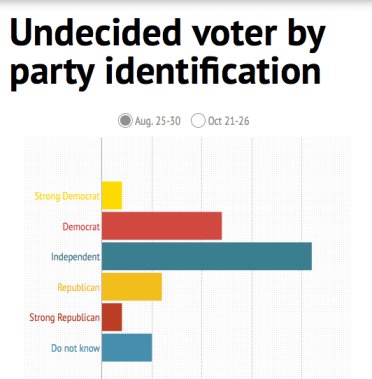Undecided voters unlikely to sway popular vote
By Melissa Kansky, Caitlin O’Donnell and Derek Wickham
Undecided voters are small in number and even smaller in significance. Typically uninformed on key election-year issues, they are also less likely to show up at the polls on Election Day, according to two professors in the department of political science at Elon University.

A recent Elon University Poll indicated 5 percent of likely voters remain undecided, a decrease of one percentage point since August. Click here for an interactive graph of the results.
According to the latest Elon University Poll, conducted Oct. 21-26, 5 percent of 1,238 likely voters reported still being undecided on the presidential race.
While little information may produce an undecided voter, others are simply torn between two issues.
“They like one candidate on one issue, but they like the other candidate on another issue, and so it could be that these various considerations are not fully weighed out in their mind,” said Jason Husser, assistant director of the Elon University Poll.
The 2012 election between former Massachusetts Gov. Mitt Romney and Presidential incumbent Barack Obama saw fewer undecided voters because of the ideological divide between the two candidates, Husser said.
Furthermore, when undecided voters are forced to pick a side, during the Elon Poll for example, undecided voters in North Carolina typically split evenly between Obama and Romney, affecting the outcome of the election little if not at all. Additionally, undecided voters nationally represent such a small sliver of the population that it’s difficult to statistically predict their impact on the election.
“They are not a group that are really indicative or representative of the population as a whole,” Husser said.
As a result, the last week of the campaign is focused more on energizing each party’s base, not necessarily getting undecided voters to the polls.
“In many ways these undecided voters have some sort of intrinsic unlikelihood of actually turning up to the polls,” he said. “(The campaigns) are less concerned with persuading this last 5 percent or fighting over the hard-to-reach people. Instead, they are focused on making sure the people who are already in their camp are showing up when they need to show up.”

Of all party affiliations, those who identify as independent have a higher percentage of undecided voters. Click here for an interactive graphic.
The typical undecided voter either has limited access to information or minimal incentive to review it, often devoting the majority of their time to other activities, he said.
“They’re doing other things, so politics in their mind is peripheral to their main interests, so they tune out,” said Kenneth Fernandez, director of the Poll. “They watch other shows besides news shows, so they’re low-information and they’re not exactly sure where these candidates stand. So they haven’t made a decision, but on Election Day they know it’s their duty, so they go out and vote.”
Students also represent another chunk of voters that are traditionally undecided, typically because they aren’t acclimated to the process, according to Fernandez. Though they may not make up their minds early, student partisanship is usually best determined by that of his or her parents, he said.

Although Fernandez said young voters are typically not acclimated to the election process, junior Raymond Haack discussed politics with members of Elon University’s Political Forum on Election Day at Speaker’s Corner. Photo by Melissa Kansky.
“Often, we don’t see the percentage of undecided likely voter numbers diminishing in surveys,” Husser said.
Since the Elon Poll conducted at the end of August, the percentage of undecided voters has declined one percentage point.
“What happens is this small amount of people end up making their mind when they walk into the voting booth,” Husser said.
Both Husser and Fernandez insisted the population of undecided voters will do little to sway the election, even if they do show up to the polls.
“I think because they split evenly, this election will be decided by turn-out, not by undecided voters,” Fernandez said. “And that’s not to dismiss undecided voters, but I would argue that a one percent increase in African American voters in North Carolina would have a larger impact on outcome than determining what small percentage of undecided voters might lean for the Republican or Democrat.”